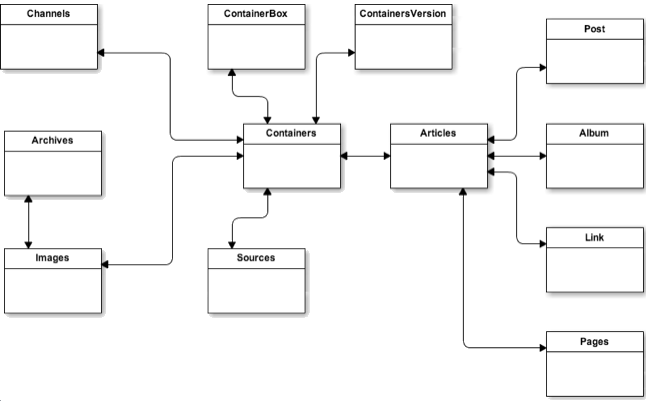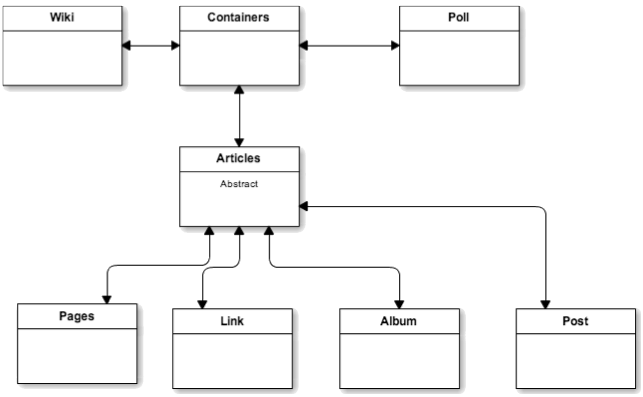The Content Archicteture

The Container Model
The content architecture starts with the Container Model. The Container is the basic model for everything in Opps. And it is important that most objects used in frontend should extend Container.
When querying for overall objects it will query for Containers.Container in this case if you don't extend it, your object
might stay out of the list, making you create a query only for it(redundant), instead of querying Containers.Container with a
filter using your specific child_class.
The conventions of a Opps site is the model opps.containers.models.Container. Each container
instance is stored in a hierarchical tree to form the content navigation, and an interface for
managing the structure of the navigation tree is provided in the admin via opps.containers.admin.ContainerAdmin.
Creating Custom Content Type
In order to handle different content type that require more structured content than provided by
the Post, Album or Link model, you can simply create your own models that inherit
from Container. For example if we wanted to have content that were music, author and studio:
from django.db import models
from opps.containers.models import Container
class Musics(Container):
music = models.CharField(_(u"Music"), max_length=140)
author = models.CharField(_(u"Author"), max_length=140)
studio = models.CharField(_(u"Studio"), max_length=200)
class META:
verbose_name = _('Music')
verbose_name_plural = _('Musics')
Next you’ll need to register your model with Django’s admin to make it available as a content type.
If your content type only exposes some new fields that you’d like to make editable in the admin,
you can simply register your model using the opps.containers.admin.ContainerAdmin class:
from django.contrib import admin
from opps.containers.admin import ContainerAdmin
from .models import Musics
admin.site.register(Musics, ContainerAdmin)
ContainerBox
Probably the most accessed class in the dashboard. With ContainerBox you can group Containers to be fetched in the front. You can fetch manually by picking containers in the inlines or you can use QuerySet to fetch automaticaly. They do not affect each other, it will depend on the front to choose between who to render, automatic or manual. Normally the best way to go is by giving priority to manual inputs(Inlines) and when those are missing/empty then you render the Queryset results in it's place.
Content Group
The ContainerBox.content_group attribute is used to give context and the ability to query for unique items(excluding repetitions). So you can fragment your page into N ContainerBoxes and make all of them use querysets from the same place and they won't repeat content as long as they share the same Content Group.
Methods
Two methods are widely used here:
- ContainerBox.ordered_box_containers (Will fetch containers from the Inlines ordered by it's order field)
- ContainerBox.get_queryset (Will fetch the containers from the Queryset associated on the ContainerBox)
One important thing is that he returns the Inline element, not the container itself, since the Inline have fields that might override the original container fields. To get the original container associated you must access the ".container" property like bellow:
{% set containerbox.ordered_box_containers as items %}
{{items.0}} {# this is a Inline element #}
{{items.0.container}} {# this is the container held by the inline element #}
ContainerBoxContainers (Inline)
It is a row like structure where you can bind containers inside it to form a group inside a ContainerBox. When binding a container and saving, it will load the matching fields content into the ContainerBoxContainer. It is important to have the same container displayed a little differently on many locations.
Mirror
It is a workaround for many-2-many relations between Containers.Container and Channels. Creates clones of the Container object to be associated in other channels and is updated by a Celery task. Should be obsolete in Opps 0.3
The Channel Model
Channel objects are used like categories and/or sections in Opps. They group content and give flexibility in templating.
Personalizing a Channel
To extend a Channel template as channel is a container you must have a folder structure like the following:
.../templates/containers/<channel-slug>/template-name.html
.../templates/containers/<channel-slug>/<sub-channel-slug>/template-name.html
To personalize any channel template you must understand how template hierarchy works. Let's suppose the folowing structure:
- /
- news/
- cars/
- economy/
- country/
- international/
From this point, the templates that target All the hypothetical channels are:
/containers/list.html
/containers/detail.html
In case I want to specify a template only for /news/cars:
# Symbolic functions
mkdir /containers/news/cars
vim /containers/news/cars/list.html
vim /containers/news/cars/detail.html
Now only for /news:
mkdir /containers/news
vim /containers/news/list.html
vim /containers/news/detail.html
Some more examples for:
Channel:
templates/containers/list.html
Content:
templates/containers/detail.html
containers/<channel-slug>/<sub-channel-slug>/<container-slug>/detail.html
containers/<channel-slug}/<sub-channel-slug>/<container-child-class>_detail.html
containers/<channel-slug>/<sub-channel-slug>/detail.html
containers/<channel-slug>/<container-child-class>_detail.html
containers/channel/detail.html
containers/detail.html
BUT when we create a template for /news All channels below will now consider this template. The only channel not affected by this template is /news/cars whose has it's own template structure. It won't be affected.
Theming the Channel
Channels have a special options called Layout this option let you choose a template type for this channel, which is mapped to a html. This option is manually controlled by a file named channel.json.
This file is hierarquically loaded like templates, and allows to create new template names which can be switched in the channel dashboard.
A example of this file could be /containers/channel.json:
{"layout": ["my_template"]}
If you choose this option in the dashboard it will look for this template:
.../templates/containers/my_template.html
This way you can prepare special templates for holidays and other temporary changes.
The Article Model
Post
Not only a simple Post but you can bind separately:
- Album
- Container
When rendering Album inside a Post there is a simple rule for the image order:
- Post main image
- Album main image
- Album binded images
Album
Group of Image objects can be binded on other Containers or rendered by itself.
Link
Representation of external links(normally) but can point to internal objects(Container). This behavior is controlled by the flag is_local.
Representation

QuerySet
The Queryset feature is inside in the Box Model, is used to gatter automatic data.
It is used together(but not uniquely) with Containerbox this way we can make the box
update by itself based on some params:
- Model (Which model to get, for example
Containers.ContainerorPost) Channel(Specific channel to grab data from)- Recursive (Look into this channels childs(subchannels) recursivelly)
- Filters (Json filters based on django query language will be passed to .filters(**kwargs))
- Excludes (same as filters but will be passed to .excludes(**kwargs) check the docs)
- Order (Passed to order_by as DESC(-) and ASC(+) if no order_field is passed, it will order by ID)
- Limit and Offset (Use like you would use python slice [offset:limit])
Custom fields
To work with custom fields need to create the field in admin and use the context in the template:
{% if context.fields.articlespost_checkbox_show_main_image_yes == 1 %}
or via templatetag:
{% get_custom_field_value context 'articlespost-checkbox-show-main-image_yes' as new_name_you_var %}
{% if new_name_you_var == 1 %}